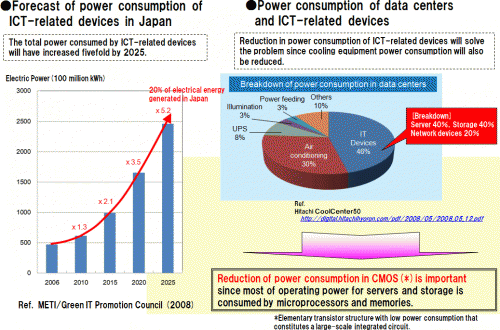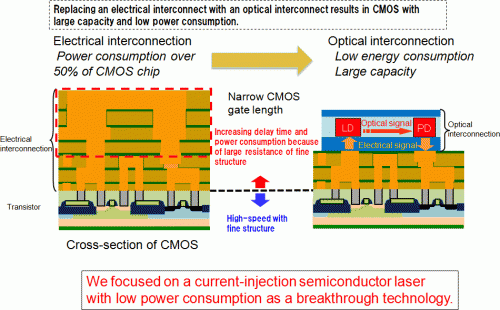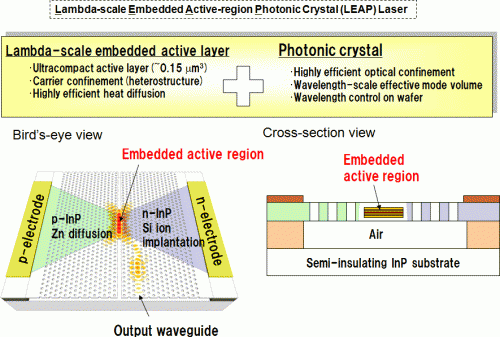Development of laser-enabling data transmission with ultra-low energy consumption

Nippon Telegraph and Telephone Corporation has developed an ultra-compact semiconductor laser (LEAP laser) enabling 10-Gbit/s data transmission with the world's lowest energy consumption. The energy consumption for 1-bit data transmission is 5.5 fJ, which is less than one-tenth that of conventional semiconductor lasers.
Microprocessors in ICT equipment such as servers and routers consume a large amount of power. In terms of replacing the currently used electrical interconnection technique for data transmissions in/between microprocessors, the optical interconnection approach using this laser will result in an approximately 40% reduction in the energy consumption of the microprocessors.
This result will be announced in detail as an Advance Online Publication in Nature Photonics magazine on May 26.
The explosive diffusion of broadband services such as FTTH and smartphones will increase network traffic 200-fold by 2025. The power consumption of ICT-related devices will increase significantly with increases in the data processing speed and throughput of computers as a result of the development of the cloud computing and supercomputer technology. It is estimated that the total power consumed by ICT-related devices will have increased fivefold by 2025 (Fig. 1).
NTT Laboratories have focused on finding a radical solution to the problem of high power consumption and heat generation in ICT equipment by reducing the power consumption of microprocessors (MPU). This is because MPUs consume most of the power in this equipment. NTT Laboratories have developed optical data transmission technologies for off-chip and on-chip optical interconnection in MPUs (Fig. 2).
NTT Laboratories have been developing the LEAP laser (Fig. 3) thus realizing the world's first continuum wave operation of a current-injection photonic crystal laser with the threshold current of 390 microamperes at room temperature (20°C-30°C). To employ this laser for optical interconnection between MPUs, one critical issue is to find a way to reduce the threshold current and thus realizing ultra-low energy consumption. An additional challenge is to realize the operation under the environmental temperature in the ICT equipment (80°C).

NTT Laboratories have clarified that the reduction of the current leakage is significant for realizing the reduction of the threshold current and the operation with ultra-low energy consumption. NTT Laboratories have developed a LEAP laser employing a current blocking layer between the laser and the substrate, and current-blocking trenches in the cavity. The world's lowest threshold current of 4.8 microamperes has been achieved. The use of the active region containing aluminum has enabled the maximum operating temperature of 95°C.
The energy consumption for the 1-bit data transmission of 10-Gb/s signals is 5.5 fJ. This is the lowest energy consumption obtained by semiconductor lasers, and is less than one-tenth that of previous results obtained by using VCSELs. The results confirm that the world's first semiconductor laser for computercom has been realized.

Reduction of leakage current outside active region
The LEAP laser has a p-i-n junction parallel to the substrate, which differs from conventional semiconductor laser structures. The previous LEAP laser suffered from current leakage because of a number of undesirable leak paths. NTT Laboratories have designed the device to concentrate the injected current only in the active region and so greatly reduce the leakage current.
1. A current blocking layer with large bandgap energy is installed under the photonic crystal slab to suppress the current leakage through the substrate.
2. A current blocking trench in formed on either side of the active region without degrading the cavity characteristics to suppress the in-plane current leakage of the photonic crystal.
InGaAlAs active region
The temperature in the microprocessors exceeds 80°C. Therefore, high-temperature laser operation is indispensable. The characteristics of high-temperature operation and high-speed modulation have been improved by changing the active layer material from InGaAsP to InGaAlAs. It was considered difficult to fabricate a buried structure with a small active region such as a LEAP laser using InGaAlAs materials, because of the problem of aluminum oxidization. NTT Laboratories have successfully overcome the fabrication problem, and achieved high-temperature operation up to 95°C and the world's highest modulation efficiency.
This result confirms that photonic crystal lasers, which have been in the basic stage, can be put into practical transmitters for optical interconnections in the microprocessors. The high laser output power and high reliability are challenges for practical optical data transmission between MPUs. NTT Laboratories are aiming to market this laser in about 2016. The large-capacity data transmission between MPUs with low energy consumption will be achieved.
Next, NTT Laboratories will attempt to fabricate a large-scale photonic network circuit by around 2022 to make it possible to commercialize on-chip data transmission in MPUs. These results will lead to a 40% reduction in the power consumption of MPUs. The fabrication of large-scale photonic integration circuits is the challenge in the future.
Journal information: Nature Photonics
Provided by NTT



















